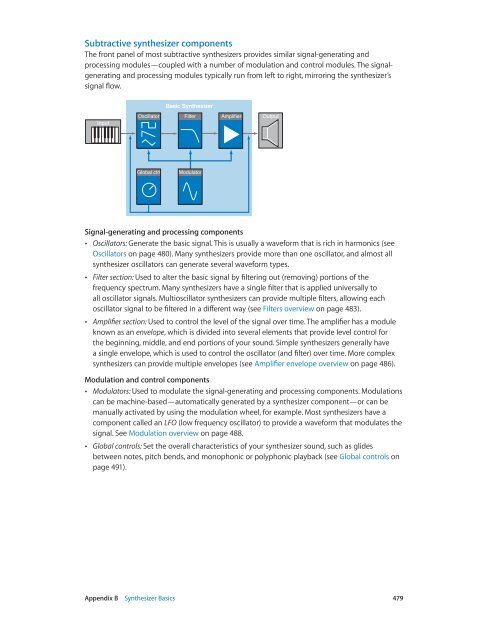Apple MainStage 3 Instruments - MainStage 3 Instruments
Apple MainStage 3 Instruments - MainStage 3 Instruments
Apple MainStage 3 Instruments - MainStage 3 Instruments
Create successful ePaper yourself
Turn your PDF publications into a flip-book with our unique Google optimized e-Paper software.
Subtractive synthesizer components<br />
The front panel of most subtractive synthesizers provides similar signal-generating and<br />
processing modules—coupled with a number of modulation and control modules. The signalgenerating<br />
and processing modules typically run from left to right, mirroring the synthesizer’s<br />
signal flow.<br />
Basic Synthesizer<br />
Input<br />
Oscillator<br />
Filter<br />
Amplifier<br />
Output<br />
Global ctrl<br />
Modulator<br />
Signal-generating and processing components<br />
••<br />
Oscillators: Generate the basic signal. This is usually a waveform that is rich in harmonics (see<br />
Oscillators on page 480). Many synthesizers provide more than one oscillator, and almost all<br />
synthesizer oscillators can generate several waveform types.<br />
••<br />
Filter section: Used to alter the basic signal by filtering out (removing) portions of the<br />
frequency spectrum. Many synthesizers have a single filter that is applied universally to<br />
all oscillator signals. Multioscillator synthesizers can provide multiple filters, allowing each<br />
oscillator signal to be filtered in a different way (see Filters overview on page 483).<br />
••<br />
Amplifier section: Used to control the level of the signal over time. The amplifier has a module<br />
known as an envelope, which is divided into several elements that provide level control for<br />
the beginning, middle, and end portions of your sound. Simple synthesizers generally have<br />
a single envelope, which is used to control the oscillator (and filter) over time. More complex<br />
synthesizers can provide multiple envelopes (see Amplifier envelope overview on page 486).<br />
Modulation and control components<br />
••<br />
Modulators: Used to modulate the signal-generating and processing components. Modulations<br />
can be machine-based—automatically generated by a synthesizer component—or can be<br />
manually activated by using the modulation wheel, for example. Most synthesizers have a<br />
component called an LFO (low frequency oscillator) to provide a waveform that modulates the<br />
signal. See Modulation overview on page 488.<br />
••<br />
Global controls: Set the overall characteristics of your synthesizer sound, such as glides<br />
between notes, pitch bends, and monophonic or polyphonic playback (see Global controls on<br />
page 491).<br />
Appendix B Synthesizer Basics 479
















